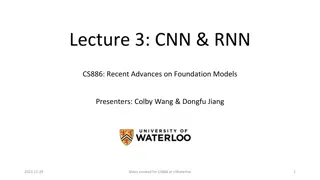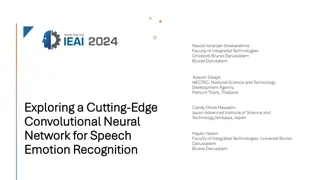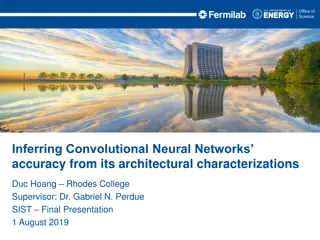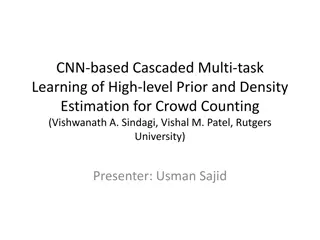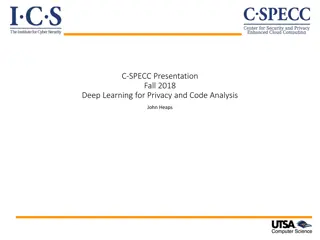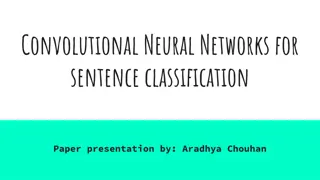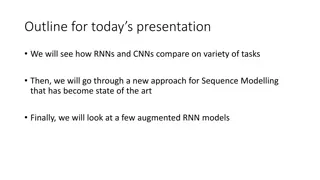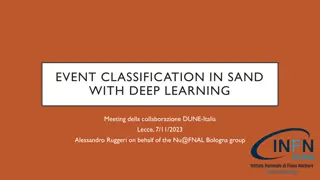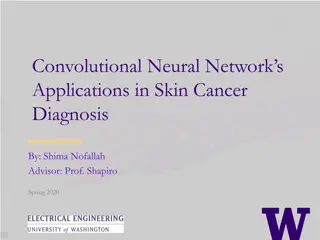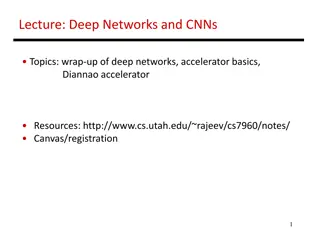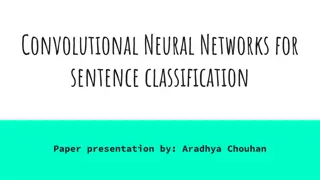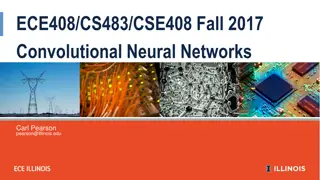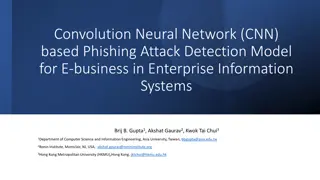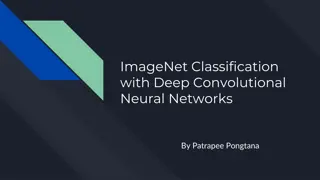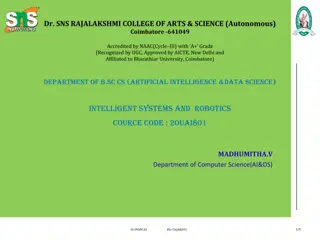Graph Neural Networks
Graph Neural Networks (GNNs) are a versatile form of neural networks that encompass various network architectures like NNs, CNNs, and RNNs, as well as unsupervised learning models such as RBM and DBNs. They find applications in diverse fields such as object detection, machine translation, and drug d
3 views • 48 slides
Recent Advances in RNN and CNN Models: CS886 Lecture Highlights
Explore the fundamentals of recurrent neural networks (RNNs) and convolutional neural networks (CNNs) in the context of downstream applications. Delve into LSTM, GRU, and RNN variants, alongside CNN architectures like ConvNext, ResNet, and more. Understand the mathematical formulations of RNNs and c
2 views • 76 slides
Exploring a Cutting-Edge Convolutional Neural Network for Speech Emotion Recognition
Human speech is a rich source of emotional indicators, making Speech Emotion Recognition (SER) vital for intelligent systems to understand emotions. SER involves extracting emotional states from speech and categorizing them. This process includes feature extraction and classification, utilizing tech
2 views • 15 slides
Convolutional Neural Networks: Architectural Characterizations for Accuracy Inference
This presentation by Duc Hoang from Rhodes College explores inferring the accuracy of Convolutional Neural Networks (CNNs) based on their architectural characterizations. The talk covers the MINERvA experiment, deep learning concepts including CNNs, and the significance of predicting CNN accuracy be
1 views • 21 slides
CNN-based Multi-task Learning for Crowd Counting: A Novel Approach
This paper presents a novel end-to-end cascaded network of Convolutional Neural Networks (CNNs) for crowd counting, incorporating high-level prior and density estimation. The proposed model addresses the challenge of non-uniform large variations in scale and appearance of objects in crowd analysis.
1 views • 17 slides
Utilizing Deep Learning for Privacy Verification in Mobile and Web Apps
Mobile and web apps are collecting personal information, posing privacy risks. Compliance verification is challenging, but deep learning can help maintain an ontology of information types, reducing ambiguity and improving analysis accuracy, as demonstrated by Convolutional Neural Networks (CNNs) in
0 views • 39 slides
Convolutional Neural Networks for Sentence Classification: A Deep Learning Approach
Deep learning models, originally designed for computer vision, have shown remarkable success in various Natural Language Processing (NLP) tasks. This paper presents a simple Convolutional Neural Network (CNN) architecture for sentence classification, utilizing word vectors from an unsupervised neura
1 views • 15 slides
RNNs and CNNs for Sequence Modelling: A Dive into Recent Trends and TCN Models
Today's presentation will delve into the comparison between RNNs and CNNs for various tasks, discuss a state-of-the-art approach for Sequence Modelling, and explore augmented RNN models. The discussion will include empirical evaluations, baseline model choices for tasks like text classification and
0 views • 20 slides
Event Classification in Sand with Deep Learning: DUNE-Italia Collaboration
Alessandro Ruggeri presents the collaboration between DUNE-Italia and Nu@FNAL Bologna group on event classification in sand using deep learning. The project involves applying machine learning to digitized STT data for event classification, with a focus on CNNs and processing workflows to extract pri
0 views • 11 slides
Emerging Variable Precision Formats in Compiler Flow
Many applications rely on floating point numbers, but deciding on the right precision is crucial to avoid performance and energy waste. This work explores the impact of precision choices, including overkill and insufficient precision, on applications such as CNNs and GPU algorithms. It introduces a
2 views • 25 slides
Applications of CNNs in Skin Cancer Diagnosis
This study delves into the utilization of Convolutional Neural Networks (CNNs) for diagnosing skin cancer, particularly melanoma. It explores the challenges in distinguishing melanoma from benign and atypical conditions at a cellular level, emphasizing the importance of accurate mitosis detection. T
0 views • 21 slides
Deep Networks and CNNs: Image Classification Benchmarks
Explore the evolution of deep networks for image classification, focusing on benchmarks like MNIST and ILSVRC. Discover the success stories of deep learning surpassing human performance in tasks like MNIST (>99%) and ILSVRC top-5 (>95%).
0 views • 36 slides
Convolutional Neural Networks for Sentence Classification: Model Architecture & Regularization
Explore the application of Convolutional Neural Networks (CNNs) in sentence classification. Learn about the model architecture, data representation, convolution operations, max pooling, and regularization techniques like dropout. This paper presentation by Aradhya Chouhan delves into how CNNs have b
0 views • 15 slides
Understanding Convolutional Neural Networks (CNNs) for Image Processing
Learn about Convolutional Neural Networks (CNNs) and how they extract higher representations of images for better classification compared to traditional image processing methods. Explore the layers, architecture, and applications of CNNs in image classification, segmentation, and generation. Discove
0 views • 17 slides
Understanding Convolutional Neural Networks and Applications
Explore the fundamentals of Convolutional Neural Networks (CNNs), including their architecture, applications in computer vision, and the advantages of using convolution layers. Dive into topics such as image processing, feature detection, and the implementation of CNNs in various domains. Leverage t
0 views • 21 slides
Analysis of Sparse Convolutional Neural Networks & Deep Compression Techniques
Explore the impact of sparsity in convolutional neural networks, focusing on memory efficiency and performance improvements. Learn about deep compression pruning methods and the use of structured sparsity learning in neural networks. Discover the Caffe framework for building and running CNNs efficie
0 views • 20 slides
Understanding Convolutional Neural Networks for Image Classification
Dive into the world of Convolutional Neural Networks (CNNs) for image classification. Explore the concepts of convolutions, pooling, and CNN training techniques like backpropagation, dropout, and stochastic gradient descent. Learn how to optimize parameters and train CNNs efficiently using GPUs and
1 views • 6 slides
Semantic Mapping of Natural Language Input to Database Entries via CNNs
Explore how CNNs are used for semantic mapping of natural language input to database entries, as discussed by Mandy Korpusik, Zach Collins, and Jim Glass from MIT Computer Science and Artificial Intelligence Laboratory. The approach involves directly mapping input to the USDA database for accurate i
0 views • 20 slides
Advanced Phishing Detection Model Using CNN for E-business
Discover the innovative use of Convolutional Neural Networks (CNNs) in combating phishing attacks in E-business and Enterprise Information Systems. Traditional methods are less effective against evolving threats, making CNNs a promising solution. This research presents a CNN-based model optimized fo
0 views • 11 slides
Achieving Fast and Robust ImageNet Classification with Deep CNNs
Explore the architecture, activation functions, GPU utilization, and conclusion of a deep convolutional neural network designed for ImageNet classification. Discover the importance of specific layers, ReLUs, GPUs, dataset size, and more in optimizing performance and accuracy.
0 views • 10 slides
Implementing CNNs in Robotics: A Deep Learning Approach
Explore the application of Convolutional Neural Networks (CNNs) in robotics, focusing on object detection, autonomous navigation, and real-time decision-making. Learn about the architecture of CNNs, challenges encountered, and steps for integrating CNN models with robot control systems for intellige
0 views • 11 slides

